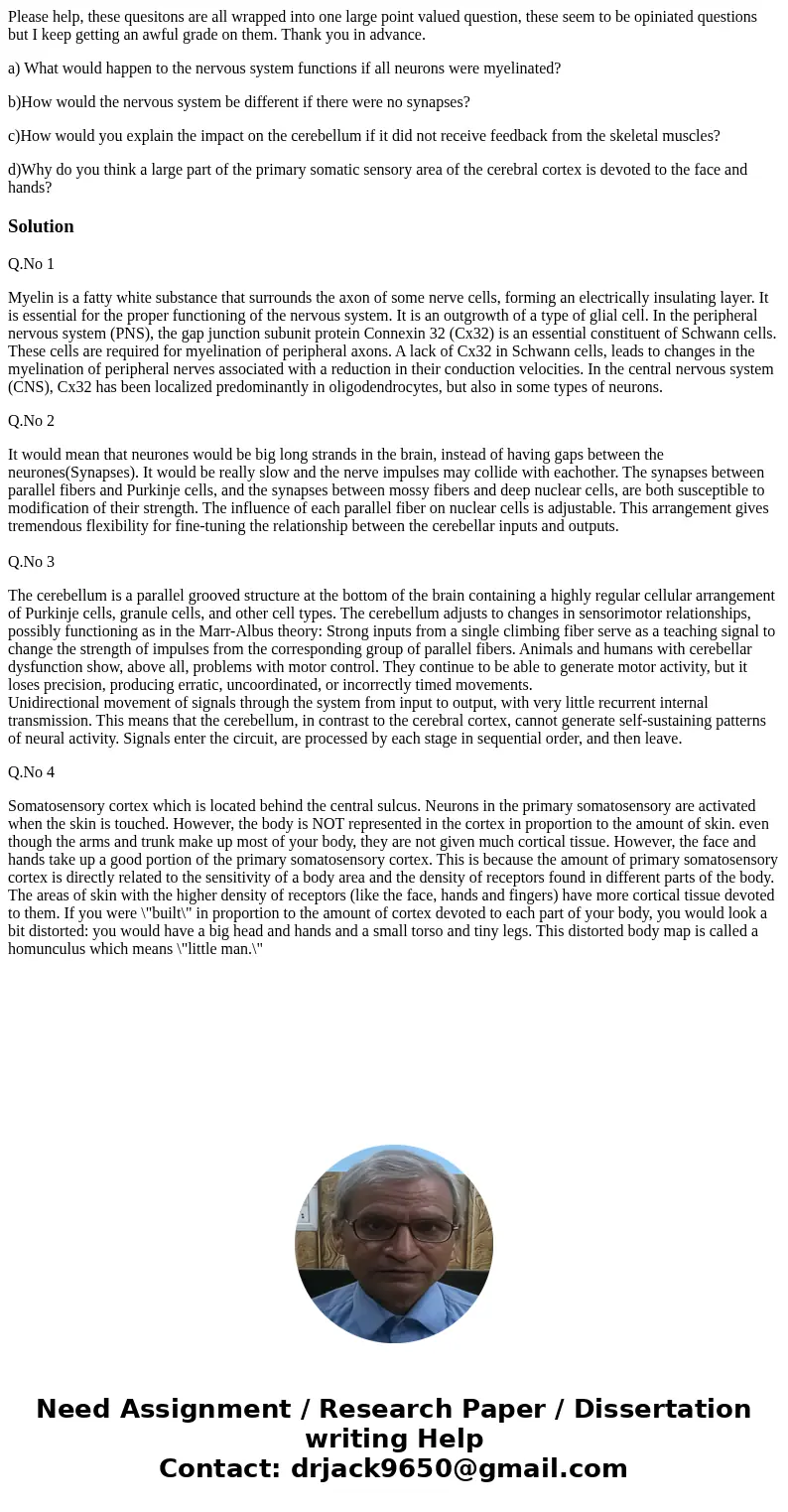Please help these quesitons are all wrapped into one large p
Please help, these quesitons are all wrapped into one large point valued question, these seem to be opiniated questions but I keep getting an awful grade on them. Thank you in advance.
a) What would happen to the nervous system functions if all neurons were myelinated?
b)How would the nervous system be different if there were no synapses?
c)How would you explain the impact on the cerebellum if it did not receive feedback from the skeletal muscles?
d)Why do you think a large part of the primary somatic sensory area of the cerebral cortex is devoted to the face and hands?
Solution
Q.No 1
Myelin is a fatty white substance that surrounds the axon of some nerve cells, forming an electrically insulating layer. It is essential for the proper functioning of the nervous system. It is an outgrowth of a type of glial cell. In the peripheral nervous system (PNS), the gap junction subunit protein Connexin 32 (Cx32) is an essential constituent of Schwann cells. These cells are required for myelination of peripheral axons. A lack of Cx32 in Schwann cells, leads to changes in the myelination of peripheral nerves associated with a reduction in their conduction velocities. In the central nervous system (CNS), Cx32 has been localized predominantly in oligodendrocytes, but also in some types of neurons.
Q.No 2
It would mean that neurones would be big long strands in the brain, instead of having gaps between the neurones(Synapses). It would be really slow and the nerve impulses may collide with eachother. The synapses between parallel fibers and Purkinje cells, and the synapses between mossy fibers and deep nuclear cells, are both susceptible to modification of their strength. The influence of each parallel fiber on nuclear cells is adjustable. This arrangement gives tremendous flexibility for fine-tuning the relationship between the cerebellar inputs and outputs.
Q.No 3
The cerebellum is a parallel grooved structure at the bottom of the brain containing a highly regular cellular arrangement of Purkinje cells, granule cells, and other cell types. The cerebellum adjusts to changes in sensorimotor relationships, possibly functioning as in the Marr-Albus theory: Strong inputs from a single climbing fiber serve as a teaching signal to change the strength of impulses from the corresponding group of parallel fibers. Animals and humans with cerebellar dysfunction show, above all, problems with motor control. They continue to be able to generate motor activity, but it loses precision, producing erratic, uncoordinated, or incorrectly timed movements.
Unidirectional movement of signals through the system from input to output, with very little recurrent internal transmission. This means that the cerebellum, in contrast to the cerebral cortex, cannot generate self-sustaining patterns of neural activity. Signals enter the circuit, are processed by each stage in sequential order, and then leave.
Q.No 4
Somatosensory cortex which is located behind the central sulcus. Neurons in the primary somatosensory are activated when the skin is touched. However, the body is NOT represented in the cortex in proportion to the amount of skin. even though the arms and trunk make up most of your body, they are not given much cortical tissue. However, the face and hands take up a good portion of the primary somatosensory cortex. This is because the amount of primary somatosensory cortex is directly related to the sensitivity of a body area and the density of receptors found in different parts of the body. The areas of skin with the higher density of receptors (like the face, hands and fingers) have more cortical tissue devoted to them. If you were \"built\" in proportion to the amount of cortex devoted to each part of your body, you would look a bit distorted: you would have a big head and hands and a small torso and tiny legs. This distorted body map is called a homunculus which means \"little man.\"

 Homework Sourse
Homework Sourse